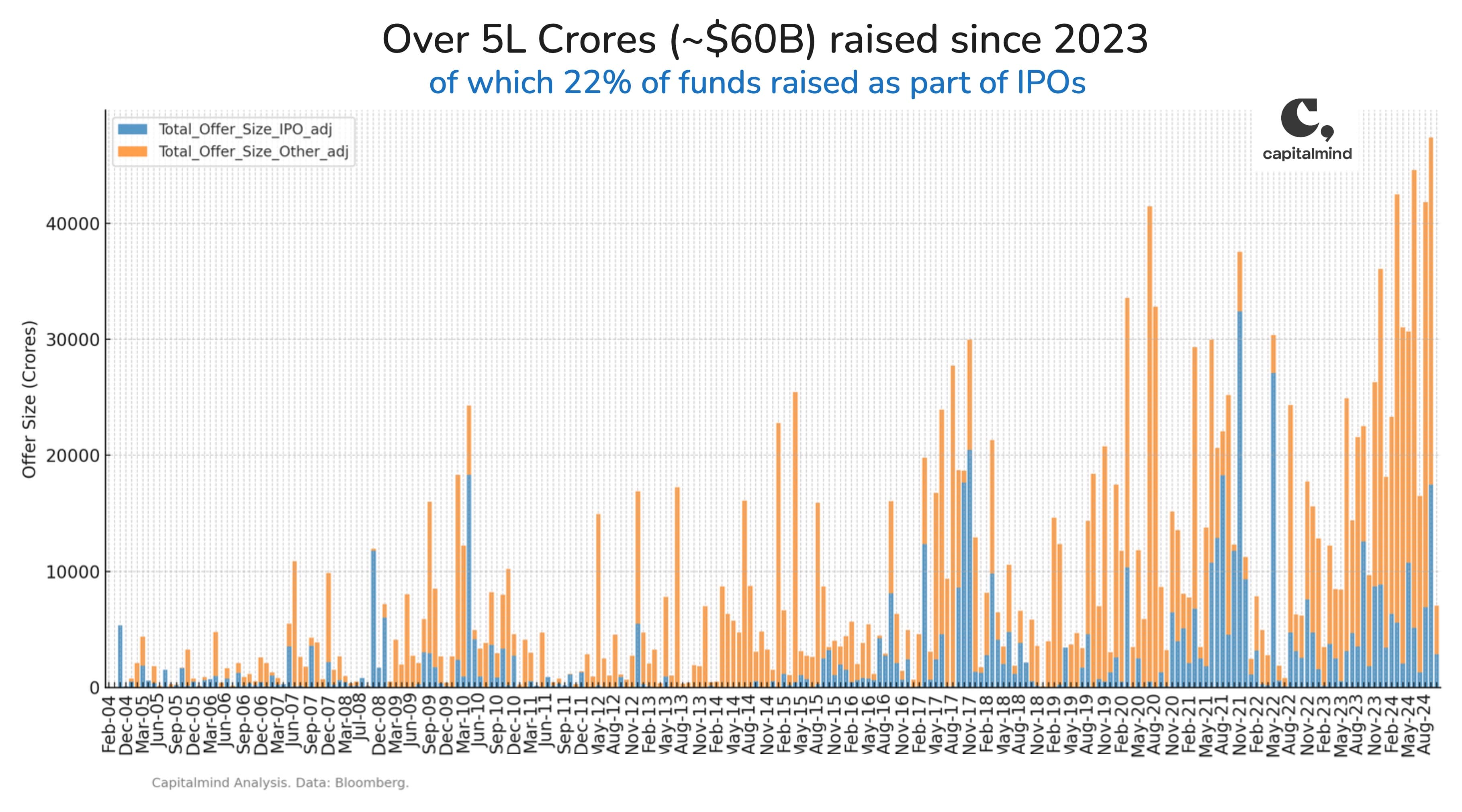(category)Charts & Analysis
Investing in mega IPOs: What the Data ShowsInvesting in mega IPOs: What the Data Shows
The recent ₹27,000 crore Hyundai IPO, the largest ever in Indian public markets, has put the spotlight on investing in initial public offerings. With companies raising over ₹5 lakh crore via share sales since 2023, and a record number of IPOs hitting the market, many investors are wondering if mega-IPOs deliver strong returns. We analyzed historical data on the top 40 Indian IPOs by size, examining factors like offer size, industry sector, price returns and total returns including dividends. The results may surprise you - while some IPOs like Zomato and Sona BLW Precision Forgings have outperformed, most of the largest IPOs have failed to beat the broader CNX 500 index, with some like Reliance Power even delivering negative returns. Before investing in the next hot IPO, learn what the data shows about the risks and rewards.
Anoop Vijaykumar•

We examined IPOs over the last two decades and specifically at large IPOs to understand the overall trend in the number of primary and secondary share sales, their offer sizes, and, finally, how the largest IPOs have performed for investors.
The chart shows the number of share sale offerings from 2004 to the present. The blue columns are IPOs, i.e., companies raising public money for the first time, and the orange columns are additional fund-raises by already public companies.
The sheer number of public offerings have risen sharply over the last two years. Nearly 600 share sales have come to market since the beginning of 2023. 335 have come so far in 2024 (as of 14th October, the day before the Hyundai IPO opened). Beyond the number, we should also look at the offer size i.e. how much money have these share sales been raising.
Chart below shows just that. The y-axis in this case is the total amount of money being raised in Crores.
A significant increase in the amount of money being raised. Since the beginning of 2023, over 5 Lakh Crores (5,00,000 Crores) has been raised via share sales.
But note how the orange columns form a bigger part of this chart compared to the previous chart. This implies existing companies have been raising a lot of the money being raised through share sales. In fact, just over 22% of total funds raised since 2023 have been by companies coming to market for the first time i.e. IPOs.
What industry sectors have most IPOs come from? Chart below shows the offer size of IPOs split by the sectors the companies have been from.
Over the years, Financials have dominated the companies raising money from the public markets. This trend continued in 2024, with 27% of funds raised by financial services companies. Interestingly, Consumer companies, both cyclical (like Auto, Hotels) and non-cyclical (like Pharma, Healthcare, FMCG, and Alcoholic Beverages) together account for 34% of all funds raised this year. They are followed by Industrial companies, accounting for 14% of IPO funds raised in 2024.
Given the interest in the Hyundai IPO, how have mega-IPOs done historically for investors who bought at the offer price and held?
It turns out not that great. The table below shows the top 40 IPOs in India by size, their listing date, price, and total return to date.
What is Total Return, and why is it different from Price Return?
Because of dividends. Total Return assumes the dividends are reinvested into buying more shares of the company at the prevailing price. Therefore, Coal India, which came to market at ₹245 in April 2010 and trades at around ₹490 as of October 2024, just about doubled in price, for a price return of 101%. However, it also paid out dividends over those 14 years, often at a yield of > 5% of the share price. If we had taken those dividends and bought more shares of Coal India at the price at the time, the Total Return from holding Coal India since its IPO would be 443%. The CNX500 has done similarly over that time frame.
Of course, since not all companies pay out large dividends, the difference between Price and Total return is not as wide for the others.
Hence, we compare the Total return with that of the CNX500 (the index of the top 500 companies by market cap) over the same period to see how investing in the IPO did versus just buying and holding the index. The chart is interactive and allows scrolling and sorting through the top 30.
- 24 of the top 40 IPOs by size have failed to generate excess returns (versus the CNX 500). This includes the impact of dividends and assuming they were reinvested in the stock.
- 12 of the 40 have delivered negative returns, with Reliance Power being the most high-profile and the largest at the time.
- Two of the top 10 have generated returns greater than the CNX500. Coal India just about doubled in price over 14 years but does much better with its dividends. Even then, it just about matches the index.
- Zomato is the only top 10 IPO that has delivered meaningful excess returns. The other big winners out of the top 40 are TCS, Hindustan Aeronautics, Indian Railway Finance Corp, Indigo, Bharti Hexacom and Bajaj Housing.
- Five of the biggest IPOs in India are from the last two years. Most of them have done well, including Bajaj Housing Finance, Bharti Hexacom, and Brainbees (First Cry), thanks in no small measure to a favourable market.
Overall, mega-IPOs don’t seem to offer lucrative returns.
There are several potential reasons. Large IPOs tend to arrive after a bull market has been underway for a while, so they tend to be priced optimistically in keeping with the prevalent appetite for risk. While the specific reasons for large IPO underperformance vary, combining the massive supply of shares these IPOs bring with the higher earnings growth expectations given the aggressive pricing tends to punish any disappointment in growth quickly.
But what about the Hyundai IPO?
Here's Deepak's take:
There are opinions about the Hyundai IPO, and I'm not going to recommend or otherwise, but two nuances you must note
Oh, it's only an Offer for Sale: versus giving the company money, you're letting the shareholder (Hyundai Korea) exit.
You actually want companies that don't…
— Deepak Shenoy (@deepakshenoy) October 16, 2024
Speak with a Capitalmind Client Advisor about a customised investment strategy consultation to see if Capitalmind PMS / AIF fits your long-term investment needs.
Related Posts
Make your money work as hard as you do.
Talk to a Capitalmind Client AdvisorInvesting is not one size fits all
Learn more about our distinct investment strategies and how they fit into your portfolio.
Learn more about our portfoliosUnlock your wealth potential
Start your journey today






